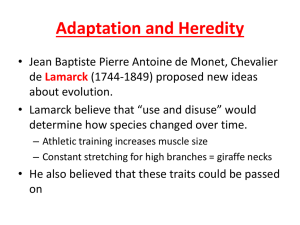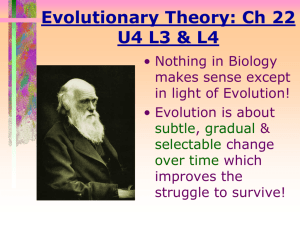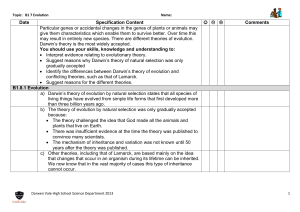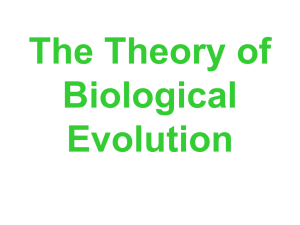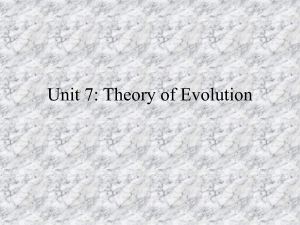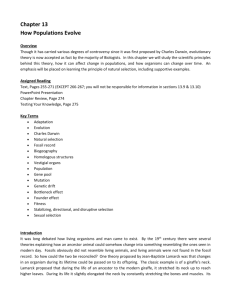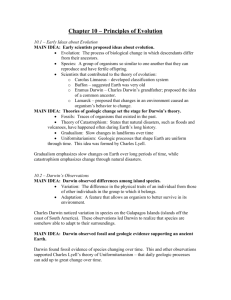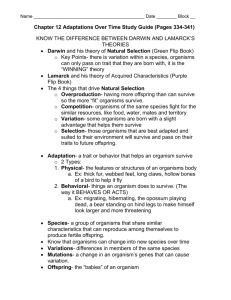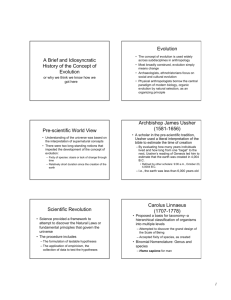File
advertisement
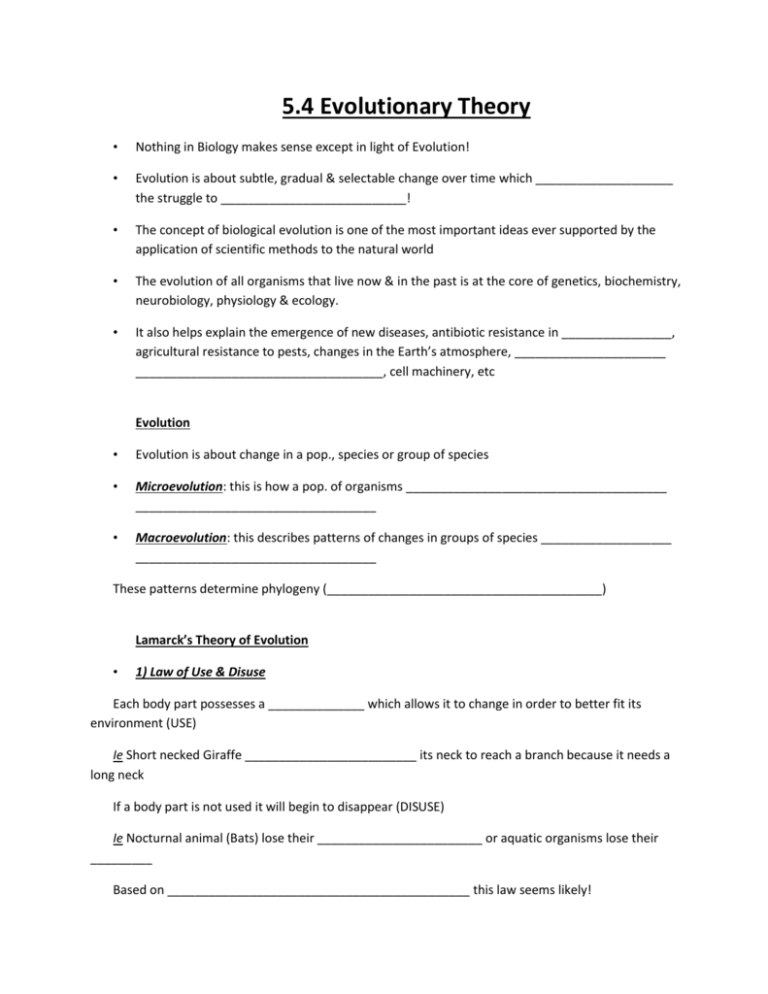
5.4 Evolutionary Theory • Nothing in Biology makes sense except in light of Evolution! • Evolution is about subtle, gradual & selectable change over time which ____________________ the struggle to ___________________________! • The concept of biological evolution is one of the most important ideas ever supported by the application of scientific methods to the natural world • The evolution of all organisms that live now & in the past is at the core of genetics, biochemistry, neurobiology, physiology & ecology. • It also helps explain the emergence of new diseases, antibiotic resistance in ________________, agricultural resistance to pests, changes in the Earth’s atmosphere, ______________________ ____________________________________, cell machinery, etc Evolution • Evolution is about change in a pop., species or group of species • Microevolution: this is how a pop. of organisms ______________________________________ ___________________________________ • Macroevolution: this describes patterns of changes in groups of species ___________________ ___________________________________ These patterns determine phylogeny (________________________________________) Lamarck’s Theory of Evolution • 1) Law of Use & Disuse Each body part possesses a ______________ which allows it to change in order to better fit its environment (USE) Ie Short necked Giraffe _________________________ its neck to reach a branch because it needs a long neck If a body part is not used it will begin to disappear (DISUSE) Ie Nocturnal animal (Bats) lose their ________________________ or aquatic organisms lose their _________ Based on ____________________________________________ this law seems likely! • Jean Baptiste Lamarck (1809)… • 2) Inheritance of Acquired Characteristics Characteristics __________________________________________________________ will be passed onto the offspring Ie Permed/dyed hair will pass on to the children Ie Body builder has kids with big muscles Ie If you lost an arm in an accident your child will be missing the limb Problems with the Lamarckian view • Use & Disuse implies an organism can sense its needs & physically change to meet those needs ______________________ I will never dunk a Basketball Ball • Acquired Characteristics can be inherited _____________________ Good hypothesis but not proven via test • Never confirmed by experiment POOR SCIENCE How Darwin formed his theory! • Darwin considered 2 pieces of info when developing his theory of natural selection Thomas Malthus’ essay: populations grow faster than the food supply which could support it (r or K?) ____________________________ Selective Breeding (Artificial Selection): breeders select _________________________ already present in a population & breed to create desirable offspring for the specific trait Darwin’s Evidence • See handout • Giraffes change due to _________________________________________________________ • Those innate traits may give an ________________________ • If you live long enough, you may pass them onto the next generation! Darwin’s Theory: 5 conditions for Natural Selection 1) Organisms ________________________ offspring 2) No 2 organisms are exactly alike (_______________________) 3) Changes in the environment occur 4) The organism ________________________________ to the new conditions will survive to reproduce 5) In time, the population will change due to ______________________________________ Objections to Natural Selection • The Church of the day he was going to be a minister so even he disliked what he was thinking • The belief that characteristics of parents blend in offspring leading to loss of variation & less to select from naturally Gregor Mendel’s work on peas proved ________________________________________ • Darwin used examples of artificial selection but never provided examples to show that natural selection works in nature. • He could not explain what _____________________________________ • Today we can! Evolution • Evolution: the ______________________________________ of the genetic composition of populations • Natural selection: populations of organisms can change over the generations if individuals having certain ___________________________________ leave more offspring than others (differential reproductive success) • Evolutionary adaptations: a prevalence of inherited characteristics that _________________ _______________________________________________ Sources of Variation • Mutations: mutagenic agents cause ____________________________ then proteins then form & structure Mutations are the ______________________________________________ • New random combinations of genes occur due to ______________________________________ • Crossing over in Prophase I • Independent assortment of homologues • Diploidy: having 2 copies of each gene allows the _______________________ ones to stay hidden Fatal recessive disease like sickle cell anemia aa-kills (a lethal combo) vs. AA or Aa who survive it Sources of Variation…. • Outbreeding: _____________________________________________________ increases the possibility of creating new gene combos • Heterozygote advantage: individual carries _____________________________________ (Aa) for a trait is better fit to survive than an individual that is homozygous (AA or aa) • Hybrid vigour: a hybrid offspring is stronger than the pure parent (less chance of getting a nasty recessive combo of genes) _____________________________ Evidence for Evolution (Review) 1) Fossil Records (Paleontology) Fossils reveal the existence of extinct species These ancestors look similar to modern species Fossils can be radioactively dated (1/2 life) to suggest great age Lots of gaps exist. WHY? Only hard parts fossilize 2) Biogeography • Uses geography to describe the distribution of species • Unrelated species in dif parts of the world look similar due to similar conditions • Helps support the effect of nat. selection 3) Comparative Embryology • Reveals similar stages of development among species • Helps establish evolutionary relationships • Gill slits in fish become middle ear parts & tonsils in us • Tails exist in many species but it is rudimentary in us • The closer organisms are related, on the phylogenetic tree, the more similar the embryos of those organisms will be! • For example, crocodilia & aves are more related than are aves & mammalia 4) Comparative Anatomy (2 kinds) • This describes 2 kinds of structures that help ID the relationship between organisms • i) HOMOLOGOUS Structures Similar body parts due to evolution from a common ancestor Similar in structure & origin but not in function Ie forelimbs (see booklet pics) • ii) ANALOGOUS Structures These body parts look alike because of natural selection to adapt to similar environments Not due to common ancestry Similar in function but not similar function or origin • 5) Molecular Biology Examines the amino acid & nucleotide sequences in Protein & DNA respectively Closely related species contain more common sequences than from those more distantly related IE Diabetics use insulin harvested from sheep & pigs Saliva, bile, digestive enzymes, hemoglobin in RBC • 6) Vestigial Organs Structures of the body that no longer serve a useful purpose but are similar to functional organs used in other organisms Over time the functional purpose has been lost Examples in humans: Appendix Tail vertebrae (100 cases exist in literature), Ear muscles Wisdom teeth (our faces are too short to allow room) Tonsils Types of Evolution • Convergent evolution- 2 different species are completely unrelated! They develop similar form due to similar ecological roles (niche is the same) natural selection has shaped these analogous adaptations • Divergent evolution species from the same evolutionary branch (related) development of different forms due to different roles and adaptations ie: Darwin’s Finches
